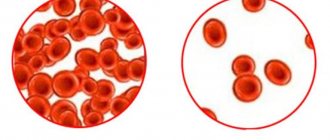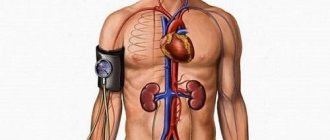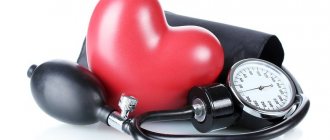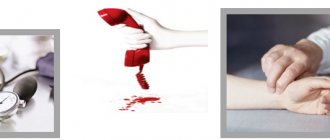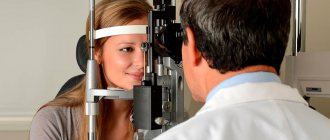Blood pressure indicators are an important diagnostic criterion by which the quality of functioning of the vascular, cardiac system, and kidney function is assessed. In a healthy person, normal blood pressure (BP) levels are considered to be 120 per 70 mm Hg. Art., however, values may fluctuate depending on age, gender, food intake and a number of other factors. If indicators increase, it is necessary to take into account the difference between systolic and diastolic pressure. So, when a pressure of 140 to 60 is recorded, the patient should consult a specialist, since an increase in the upper reading may indicate the development of arterial hypertension. What does this mean for the patient’s health, and what conditions provoke dissonance between indicators?
Reasons for the growth of indicators
The difference between the values of systolic and diastolic pressure is called pulse pressure, which is an indicator of the functional state of the cardiovascular system. A pressure of 140 over 60 indicates a pathological increase in the upper reading and a moderate decrease in the lower reading, which is characteristic of isolated systolic hypertension. The pulse difference may be due to age-related vascular changes, when the upper pressure increases in different age categories, and the lower pressure increases mainly in people over 45 years of age. In this condition, an increase in pulse pressure occurs without exception, but the average blood pressure level can remain unchanged.
A pressure of 140 over 60 can be either short-term or permanent, which is a sign of the development of a pathological condition in the body. The reasons for the increase in the upper blood pressure indicator are the following processes:
- increased strength of heart contractions;
- rapid pulse;
- excessive vascular tone;
- sclerotic process in arterial walls;
- blocking the lumen of a vessel with atherosclerotic formation.
A decrease in diastolic indicator is associated with a decrease in the elasticity of the arterial walls, resulting in hemodynamic disorder. In hypertensive patients, diastolic pressure may decrease as a result of improper use of long-acting antihypertensive drugs. This disorder is short-term in nature, since the lower indicator is restored over time. Short-term changes in blood pressure levels can also be triggered by stressful situations or physical fatigue.
High blood pressure in older people: hypertension
Increasingly, as people age, they complain of ailments. High blood pressure in older people is common. When the tonometer readings are above 140/85, we are talking about the development of hypertension. The disease is found everywhere. There are many reasons for its development:
- predisposition in the family;
- excess weight;
- sedentary lifestyle;
- stress;
- poor nutrition;
- smoking and alcoholism.
Increased blood pressure is caused by a large number of diseases that appear with age. They lead to changes in the body:
- the amount of extracellular fluid increases, swelling appears;
- the walls of blood vessels hypertrophy;
- the speed of blood flow changes;
- the kidneys cannot remove fluid;
- cardiac output decreases.
All these changes are considered unfavorable for the elderly. They entail a gradual increase in pressure, often leading to a hypertensive crisis.
What diseases contribute to pulse differences?
A significant pulse difference may indicate the development of pathological conditions in the body that require emergency medical care. High pulse pressure can be caused by various reasons. Thus, a PP of more than 60 mmHg is considered a deviation from the norm. Art. To determine PP, a special formula is used, for example, with indicators of 140/60, its value will be equal to 80 mm Hg. Art. (140-60=80). In the presence of pathologies, blood pressure will remain at a constant level, reflecting degenerative changes in organs and systems.
As a rule, high systolic pressure in combination with low diastolic pressure is observed in elderly people. The imbalance is caused by the progression of the atherosclerotic process, which, affecting the vascular system, reduces the flexibility of the arteries.
The main diseases characterized by a high pulse difference:
- Atherosclerosis.
- Cardiac ischemia.
- Chronic heart failure.
- Arterial hypertension.
- Hyperfunction of the thyroid gland.
- Endocarditis.
- Total vascular spasm.
Important! A sharp increase in systolic pressure with a decrease in heart pressure increases the risk of stroke and myocardial infarction. In addition, insufficient blood supply to the adrenal cortex and degenerative changes in the cardiac chambers are diagnosed.
Low blood pressure and high pulse: what to do
Low blood pressure: causes, possible pathologies, first aid
If a person has a high pulse (scientific names: tachycardia, rapid pulse) or low pulse (scientific names: slow pulse, bradycardia) along with low blood pressure, he needs to undergo a comprehensive examination, as these combinations often indicate serious health problems. Start by visiting a therapist. After making an accurate diagnosis, the doctor will recommend what needs to be done to improve your well-being and treat the identified pathology.
Low blood pressure and increased heart rate after drinking coffee or alcohol
There are many reasons why the pulse quickens, but at the same time the pressure drops. This can happen in the background:
- alcohol abuse;
- taking medications, including beta blockers, diuretics;
- consumption of tonics, coffee;
- insufficient physical activity.
Caffeine, energy drinks, alcohol, and nicotine cause increased heart rate, but each body’s reaction to them is individual. For some people, coffee increases blood pressure, while for others it decreases. Even if the appearance of a high pulse and low blood pressure is caused by the factors mentioned above, it is necessary to consult a therapist, since drinking coffee or smoking can increase the manifestation of hidden pathologies.
Vegetative crisis
This condition has a paroxysmal nature and develops in most cases with excitement or overheating. An attack can occur even in a sleeping person - in this case, unpleasant sensations force one to wake up.
Symptoms of a vegetative crisis:
- severe weakness;
- pale skin;
- trembling, tremor;
- profuse sweating;
- dull pain throughout the body;
- nausea, vomiting;
- tinnitus;
- darkening of the eyes;
- dry mouth;
- difficulty speaking and gait disturbances with preserved consciousness;
- high pulse;
- low blood pressure.
It may seem to the observer that the person has suddenly become intoxicated: he has turned pale, his speech has become unclear, his gaze has become unfocused, and his gait has become unsteady. These symptoms are of an increasing nature; the crisis usually reaches its peak 10–15 minutes after the first signs appear.
What to do to help the victim:
- lay down or sit down;
- help remove warm clothes;
- put cold water and warm coffee or tea with sugar nearby;
- provide a flow of fresh air.
The crisis can last from 5 minutes to half an hour; in most cases, calling an ambulance is not required. If such attacks occur against the background of overheating in an apparently healthy person, it is necessary to make an appointment with a neurologist: this is how demyelinating diseases and other pathologies of the nervous system can manifest themselves. If there is no connection with changes in external temperature, you should be examined by a cardiologist and endocrinologist.
Diseases of the heart and blood vessels
The combination of a high pulse and low blood pressure often indicates congestive heart failure. In this case, there is weakness of heart contractions, which is partially compensated by an increase in their frequency. Therefore, the pressure will be low, but the pulse will be high. Please note: without treatment, this pathology eventually leads to a heart attack.
High pulse and low blood pressure can also be caused by atherosclerosis. Due to the buildup of cholesterol plaques or stenosis, arterial resistance increases, causing the heart muscle to contract more to pump blood.
Hyperthyroidism
One of the manifestations of the disease associated with increased production of thyroid hormones is a high number of heartbeats. At the same time, some patients have low blood pressure rather than high blood pressure.
The development of hyperthyroidism may be indicated by:
- increased appetite with rapid weight loss;
- anxiety;
- heat intolerance;
- tremor.
If you have these symptoms, you need to be examined by an endocrinologist.
Impaired production of cortisol and other corticosteroids
Pathologies of the adrenal glands, including Addison's disease, lead to a decrease in the production of the hormone cortisol, which affects vascular tone. The body compensates for the resulting circulatory failure by increasing the heart rate.
Increased heart rate and low blood pressure are sometimes associated with high cortisol levels. Increased production of this hormone may be a consequence of pituitary or adrenal tumors.
Diabetes and other diseases of the endocrine system
A high pulse and low blood pressure sometimes indicate such a common and dangerous disorder as diabetes. Often patients do not know about their diagnosis for a long time, which leads to accelerated development of the disease due to lack of treatment.
The following signs may suggest the presence of diabetes:
- sudden, unexplained change in weight (with type 1 diabetes, weight usually decreases, with type 2 diabetes it usually increases);
- frequent urination;
- drowsiness;
- irritability.
Low blood pressure and low pulse: what to do
The combination of low blood pressure and low pulse can be caused by various reasons:
- isolated heart rhythm disturbances, coronary heart disease - you need to consult a cardiologist;
- constant intense training (athletes often experience a decrease in blood pressure and pulse at rest) - observation by a therapist is necessary to exclude the development of pathologies;
- hypothermia - in normal general condition, medical assistance is not required; in case of severe prolonged hypothermia with deterioration in general condition, the help of a doctor is needed;
- hypothyroidism (decreased levels of thyroid hormones) – treatment by an endocrinologist is necessary;
- intoxication, uremia, sepsis, some pathological changes during pregnancy - in all cases emergency medical care is required.
Thus, with low pressure in combination with changes in pulse, you cannot self-medicate. Such conditions can be signs of dangerous pathologies, each of which is treated in its own way. You need to make an appointment with a doctor and begin the examination.
Provoking factors
An unhealthy lifestyle negatively affects the functional state of the cardiovascular system. Various factors influence changes in pulse pressure and aggravate the course of pathologies.
Provoking factors causing differences in blood pressure levels:
What does it mean when systolic pressure is high and diastolic pressure is low?
- excess body weight;
- deficiency of microelements and vitamins;
- mental and physical stress;
- alcohol abuse;
- hypovolemia;
- metabolic disease;
- cardiosclerosis;
- cirrhosis of the liver;
- pathology of the adrenal cortex.
Systolic hypertension at a young age is caused by poor nutrition, bad habits and exposure to frequent stressful situations. Systematic violation of the rest and work regime causes changes in biological rhythms, which lead to disruption of the nervous system, which is reflected in the growth of the upper indicator.
Signs of the condition
The symptoms of the pathological condition are similar to the clinical picture of arterial hypertension, when fluctuations in blood pressure levels affect the functional state of the main organs and systems.
The first signs of systolic hypertension are:
- recurrent headaches;
- causeless fatigue;
- visual impairment;
- squeezing pain in the chest area;
- decreased tolerance to physical activity.
An increase in systolic pressure is accompanied by headache, which is localized in the temporal and parietal zones
When the level of upper pressure increases and the lower pressure remains normal, pain occurs in the myocardium. Patients experience pressing pain that increases with physical activity and decreases with rest.
When systolic hypertension is combined with a slow pulse, the circulatory process is disrupted, which leads to damage to the brain and myocardium. When the pulse becomes critically low (less than 55), sharply reduced hemodynamics provokes the occurrence of a heart attack, stroke, as a result of impaired hemodynamics of myocardial and brain cells. With minor changes in the contractile activity of the heart muscle, compensatory mechanisms are activated to prevent the development of acute conditions. However, the combination of bradycardia with high pulse pressure is a reason to consult a specialist.
How to treat high blood pressure
An increase in blood pressure cannot always be noticed without using a tonometer. Often the symptoms are similar to general fatigue and overwork. In the absence of help, the disease gradually gains unpleasant momentum.
As an emergency treatment, drugs that have an immediate effect are used.
The drugs are available in different dosages, so a doctor’s advice is required so as not to harm the body, but to prevent the development of a stroke. To obtain a hypotensive effect, the tablet is placed under the patient’s tongue and gradually dissolves.
If you have hypertension, you will have to constantly take medications to keep your blood pressure normal. Their effect is usually limited to a day. To obtain a cumulative effect, hypertensive patients are advised to take prescribed medications at one time of day.
To control the disease, complex therapy is sometimes prescribed. Antihypertensive, diuretic, and cardiac medications are used. If there is no desired effect, the medications must be changed after 2 weeks.
No drug is used without a doctor's prescription. The treatment regimen is selected individually.
Only a doctor determines the need to use diuretics, beta and alpha blockers.
Decrease in diastolic indicator
One of the most common pathologies is a decrease in diastolic reading with high systolic pressure. Thus, a pressure of 140 to 50 increases the risk of a heart attack as a result of excessive stress on myocardial cells.
Prolonged maintenance of this level of blood pressure negatively affects the functioning of the cardiovascular system, since increased load depletes cardiomyocytes, which can lead to the formation of coronary heart disease. The pathological condition poses a threat to the body of both elderly and young patients. If indicators are detected, you should immediately contact a cardiologist for a thorough diagnosis of the cause of the condition.
What to do?
Self-medication is strictly not recommended. What to do if the pressure is 140 over 60, only a doctor should decide.
Only medical professionals can choose the right drug after they have conducted an examination and identified the immediate and reliable cause of the increase in arterial and pulse blood pressure.
If a person’s blood pressure is 140 over 60, then it is better to consult a local physician. As drugs that can be used independently, you can use:
- diuretics;
- Folic acid (normalizes heart function).
All other drugs are prescribed by a doctor depending on the cause of the disease.

